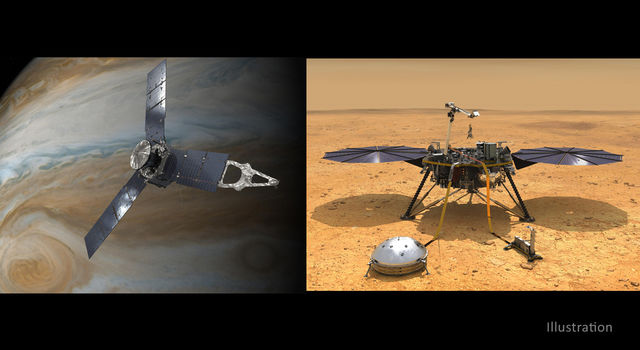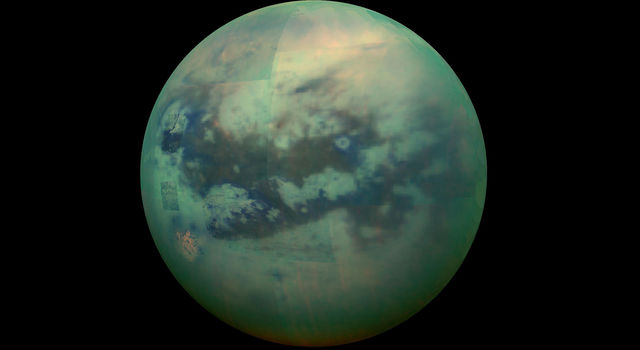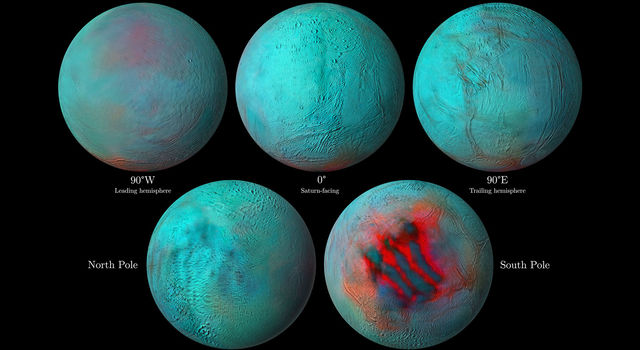Blogs | JPL | March 1, 2010
Road-Tripping to Rhea with Cassini
Here in Cassini-land, we are really excited about Tuesday's Rhea flyby! This will be the mission's second targeted flyby of the moon in the mission, so it's sometimes referred to as R-2 or Rhea-2.
The spacecraft will fly by Rhea at an altitude of about 100 kilometers (60 miles), the closest encounter yet with Saturn's second largest moon. (Our first targeted flyby of Rhea in 2005 was at an altitude of 500 kilometers, or 300 miles, so this is way closer.)
We've been focusing a lot on the moon Enceladus because it is sort of the darling of the Saturn system -- but Rhea is a good example of why the other moons are interesting too. We know a decent amount about this moon, but we still have more questions, especially about the debris that could make up a ring around the moon and the composition of its surface.
The first targeted flyby in 2005 was focused on a radio science experiment doing gravity measurements to understand Rhea's interior structure. We also got some nice remote-sensing data from the cameras and spectrometers (see for example PIA07764) as well as radar measurements for surface and subsurface composition. We also did a much more distant flyby (5,000 kilometers or 3,000 miles) of Rhea in August 2007; that flyby was dedicated to remote sensing of the moon, including imaging (such as PIA08402). So we have a pretty good understanding of Rhea as being pretty heavily cratered with no super obvious signs of activity. It has this "wispy terrain" (see PIA08120), which is a lot like the type of feature seen on another Saturnian moon, Dione, and is basically a large series of fractures that are relatively bright compared to the surrounding regions.
One of the most interesting results to come out of the 2005 and 2007 flybys came from the fields and particles instruments: the mysterious signature of electron depletion around Rhea, suggestive of a debris ring. (Basically, solid material appears to be absorbing electrons in the vicinity of Rhea.) So Rhea could be a moon with its own ring! The ring has not been seen by any of the remote sensing instruments on Cassini, however. It can be difficult to get the viewing geometry just right in order to see this type of thing -- recall that the Cassini cameras didn't definitely see Enceladus' plume until after being in orbit for more than one year!
Tuesday's flyby should give us some clues about the suspected debris disk around the moon, but the slam-dunk experiment to "see" Rhea's debris disk is what we call a stellar occultation through the ring plane - looking to see if debris particles or clumps block out light from stars. Unfortunately we won't get to do such an occultation on this flyby. This is a tricky experiment to do because you have to get the timing and the geometry just right, but we're hoping to do it at some point later in the mission.
Anyway, on to Tuesday's flyby! To get a sense of what we're going to do, check out the movie made by Cassini navigator Brent Buffington that shows each of the activities performed during the flyby.
We will approach Rhea on the night side, so the moon will be dark. This is an especially good opportunity for the radar instrument to make measurements. (The cameras and imaging spectrometers typically prefer to observe the dayside, not the nightside.) Radar will do synthetic aperture radar imaging scans similar to those at Titan and will also do measurements to understand the surface composition. Previous measurements had suggested an asymmetry in brightness (which could be due to compositional differences) between the leading and trailing hemispheres of the moon, so this flyby will help with investigating that.
At closest approach, the fields and particles instruments will take data that will help us understand the environment of Rhea -- its interaction with Saturn's magnetosphere, its debris disk, and its ejecta cloud density. Ejecta clouds are dust or material that is being ejected or sputtered or otherwise lost from Rhea and its environment and contributing to populations of neutral particles and plasma in the Saturn system. This material may also be contaminating Saturn's rings.
Outbound, the remote sensing instruments will take over. They will make measurements -- in wavelengths as short as the ultraviolet all the way to the far infrared -- of Rhea's surface terrains and composition, as well as its surface temperature. The cameras have seen some "bluish spots" that could be related to the debris ring material - so those regions will be investigated more during this encounter, as will the fractured "wispy" terrain. The visual and infrared mapping spectrometer and the ultraviolet imaging spectrograph will do imaging spectroscopy to search for and map out water ice grain sizes, carbon dioxide, ammonia and fine-grained iron particles, among other materials. The composite infrared spectrometer will map temperatures across portions of Rhea's sunlit disk at high resolution. Ninety minutes after closest approach, Rhea will enter Saturn's shadow, giving the composite infrared mapping spectrometer a good opportunity to measure the cooling of the surface, which will provide information about the texture of the uppermost surface layers.
But wait - there's more! Not only do you get a Rhea flyby, but we're going to throw in a close approach to the small moon Helene! Helene is one of the "co-orbitals" of Dione. That means it orbits Saturn at the same radial distance as Dione, but it happens to be 60 degrees ahead of Dione. Helene is only about 30 or 35 km across (19 or 22 miles) and it's not spherical (see PIA10544). Cassini will approach Helene within about 1,825 kilometers (1,130 miles) -- by FAR the closest we've ever gotten to Helene -- allowing the cameras and imaging spectrometers to obtain information about individual regions across the surface.
So this promises to be an exciting period. Please stay tuned to see the great results!
TAGS:SOLAR SYSTEM, SATURN, CASSINI, FLYBY, RHEA








